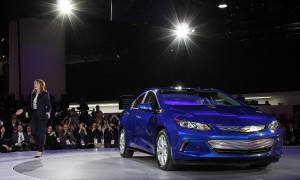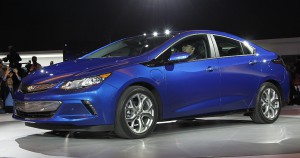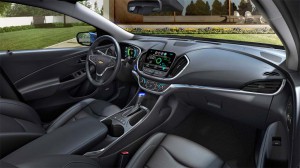
GM CEO Mary Barra introduced the second-generation Bolt, which will get an additional 50 miles per charge. Photo credit: Len Katz.
General Motors sparked plenty of interest when, in 2010, it launched the world’s first mass-market plug-in hybrid-electric vehicle, the Chevrolet Volt. But after an initial surge, sales have waned over the last several years, falling a precipitous 30% last year. So, Chevy can only hope that potential buyers will plug back in with the launch of an all-new, second-generation Volt at this week’s North American International Auto Show.
The 2016 model was designed to address many of the weaknesses of the original car, including its buzzy engine, sluggish performance and cramped interior. But it also will deliver significantly more range – an estimated 50 miles per charge – and improved fuel economy.
And while the maker has yet to announce specific numbers, there is widespread speculation the 2016 Chevrolet Volt also will see a price cut putting it more into the mainstream of the compact American sedan market.
“We think the new Volt is launching from a position of strength,” proclaimed Steve Majoros, the director of Chevrolet Marketing, during a preview of the 2016 Volt. The goal, he said, “is to bring more people to the franchise.”

The gen-2 Chevrolet Volt is designed to spend even more time operating in electric mode. Photo credit: Len Katz.
Chevy certainly has to hope so considering that Volt – once the best-selling plug-based vehicle in the country – has slipped behind the Nissan Leaf, the pure battery-electric vehicle that has continued to gain ground despite its age and the current plunge in fuel prices.
(Click Here for a quick guide to the most important debuts at the 2015 North American International Auto Show.)
There’s no question the original Volt was a groundbreaking concept. Indeed, many industry analysts believe it is the right concept, just a weak execution. Officially called an “extended-range electric vehicle,” the sedan is meant to drive primarily on electric power, and only when its batteries run down does the back-up internal combustion engine fire up. According to data on Volt owners, they typical go as much as 900 miles between fill-ups because they keep the gen-1 car’s lithium-ion batteries charged up whenever possible.
The goal is to increase range from an EPA-rated 35 miles for the original Volt to 50 miles with the gen-2 plug-in, according to Executive Chief Engineer Pam Fletcher. And, in the process, that should allow owners to get more than 1,500 miles between fill-ups. Fuel economy when running on gasoline to climb to 41 miles per gallon, while the EPA’s MPG-e, or miles per gallon-equivalent, rating shoots to 102.
(Buick drops its top with new Cascada convertible. Click Here to check it out.)
“We were given an opportunity to do a clean-sheet, all-new Volt,” she said during the unveiling, noting that while some parts of the car are carryover, most key components have been replaced or updated, while the overall parts count has been reduced.
That includes the electric drive system which now uses two smaller but more powerful motors. The battery pack now has fewer cells and takes up less space, but it increases in capacity by more than 10%, to 18.4-kilowatt-hours. And the new 2016 Volt can draw deeper into each charge to improve efficiency and range – and boost performance.
The new Volt adopts a more advanced new 1.5-liter inline-four range-extender gas engine that promises to be smoother and quieter than the original back-up powertrain. The engine produces up to 101 horsepower. At its peak, the 2016 Chevy Volt will produce a maximum 149 horsepower, with torque jumping to a full 294 pound-feet. That’s why the development team was able to trim a half-second off the new Volt’s 0 to 60 launch time, now an estimated 8.4 seconds.
Chevy offered a sneak peek at the new Volt at the Consumer Electronics Show in Las Vegas last week, generating a fair bit of controversy. Design chief John Cafaro said the goal was to come up with a sleek, aerodynamic body that delivered some visual excitement.
“We wanted it to be ‘eco’ with a little attitude,” said Cafaro
Whether moving away from the admittedly quirky but distinctive look of the gen-1 Volt will pay off remains to be seen. Rival Toyota has effectively used the oddball look of the Prius to build an unmistakable identity for that hybrid.
Few are likely to complain about the changes to what was a cramped and dull original Volt. The new version moves decidedly up-market with more refined and sophisticated colors and materials. There are nice new features, including heated rear seats and a heated steering wheel, as well as new twin eight-inch LCD displays, a touchscreen version topping the center console.
Meanwhile, there are plenty of new and updated safety features, including a standard rearview camera, 10 airbags and optional equipment including cross-traffic alert and forward collision warning.
The most notable change, however, is the downsizing of the big T-shaped battery pack that divided the original Volt into quadrants. The smaller pack in the 2016 plug-in allows a fifth passenger to sit in the rear, although “You wouldn’t want to go cross-country,” admitted lead engineer Andrew Farah.
(Jaguar will launch its first crossover-utility vehicle. Click Here for more on the new F-Pace.)
Despite the larger battery, charging times on 240-volts will remain about 4.5 hours, though using a household 110-volt outlet will require a bit more time, at 13 hours. For now, no Level III charging is allowed, but Farrah said that could come mid-lifecycle.
Will all the changes charge Volt back up? Consider that it will now be able to handle about 90% of the driving of the typical American without using any gasoline. Of course, gasoline has become a lot cheaper than when the original Volt made its debut, a factor impacting all battery-based vehicles.
Nonetheless, the new 2016 Chevrolet Volt has a lot going for it and could regain much of the momentum it has lost over the last couple years – especially when fuel prices do start climbing again.

